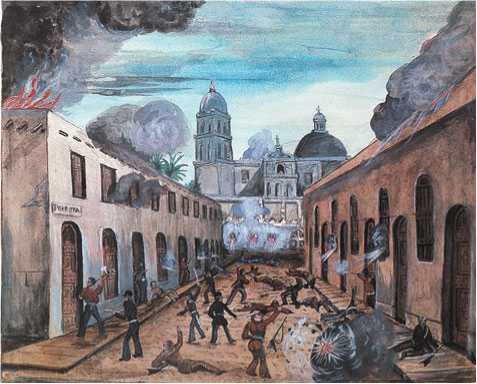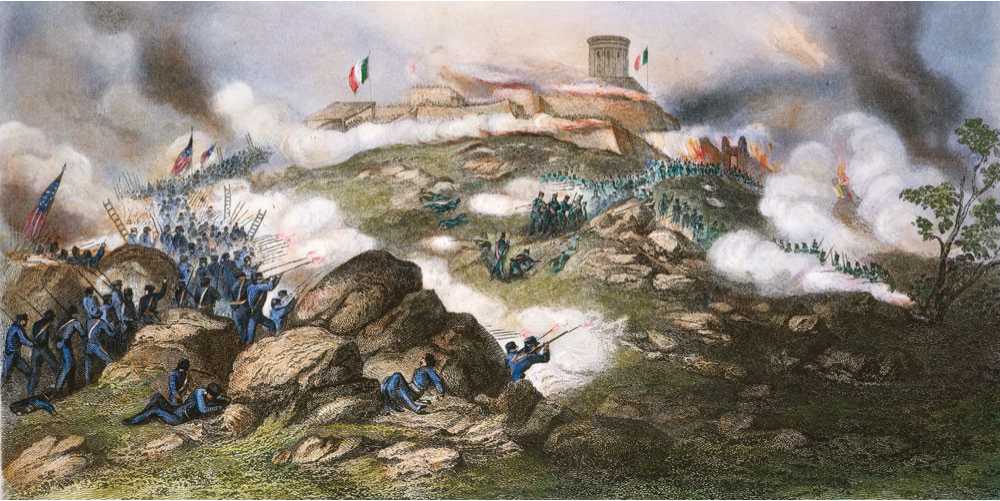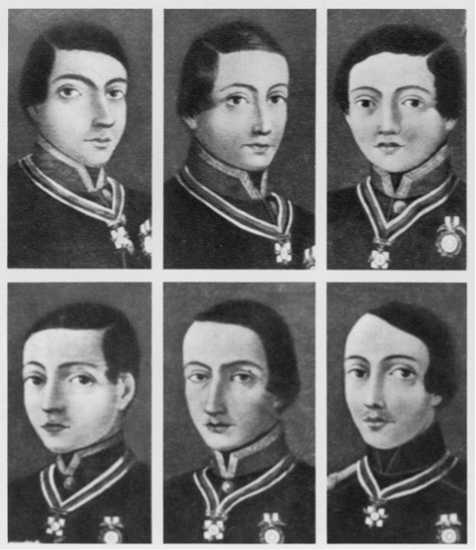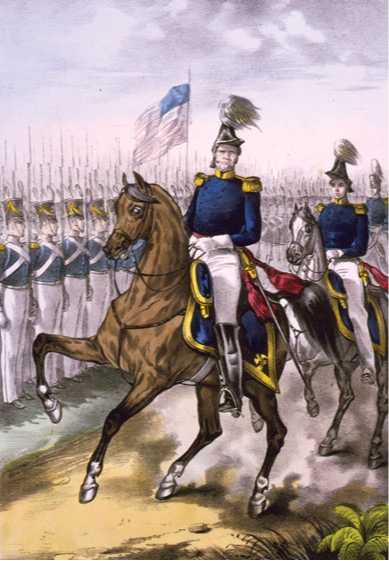President Polk insisted not only on directing grand strategy (he displayed real ability as a military planner) but on supervising hundreds of petty details, down to the purchase of mules and the promotion of enlisted men. But he allowed party considerations to control his choice of generals. This partisanship caused unnecessary turmoil in army ranks. He wanted, as Thomas Hart Benton said, “a small war, just large enough to require a treaty of peace, and not large enough to make military reputations dangerous for the presidency.”
Unfortunately for Polk, both Taylor and Winfield Scott, the commanding general in Washington, were Whigs. Polk, who tended to suspect the motives of anyone who disagreed with him, feared that one or the other would make political capital of his popularity as a military leader. The examples of his hero, Jackson, and of General Harrison loomed large in Polk’s thinking.
Polk’s attitude was narrow, almost unpatriotic, but not unrealistic. Zachary Taylor was not a brilliant soldier. He had joined the army in 1808 and made it his whole life. He cared so little for politics

American soldiers—some of them regulars in deep blue uniforms, others in buckskin cowboy outfits—fight in the streets to drive Mexicans from a Spanish mission in Monterrey, California, in 1846.

This image depicts the Battle of Chapultepec (1847). At the right are portraits of six fifteen-year-old cadets at the military school at Chapultepec Castle who committed suicide rather than surrender to the American attackers.
That he had never bothered to cast a ballot in an election. Polk believed that he lacked the “grasp of mind” necessary for high command, and General Scott complained of his “comfortable, laborsaving contempt for learning of every kind.” But Taylor commanded the love and respect of his men (they called him “Old Rough and Ready” and even “Zack”), and he knew how to deploy them in the field. He had won another victory against a Mexican force three times larger than his own at Buena Vista in February 1847.
The dust had barely settled on the field of Buena Vista when Whig politicians began to pay Taylor court. “Great expectations and great consequences rest upon you,” a Kentucky politician explained to him. “People everywhere begin to talk of converting you into a political leader, when the War is done.”
Polk’s concern was heightened because domestic opposition to the war was growing. Many Northerners feared that the war would lead to the expansion of slavery. Others—among them an obscure Illinois congressman named Abraham Lincoln—felt that Polk had misled Congress about the original outbreak of fighting and that the United States was the aggressor. The farther from the Rio Grande one went in the United States, the less popular “Mr. Polk’s war” became; in New England opposition was almost as widespread as it had been to “Mr. Madison’s war” in 1812.

Polk’s design for prosecuting the war consisted of three parts. First, he would clear the Mexicans from Texas and occupy the northern provinces of Mexico. Second, he would take possession of California and New Mexico. Finally, he would march on Mexico City. Proceeding west from the Rio Grande, Taylor swiftly overran Mexico’s northern provinces. In June 1846, American settlers in the Sacramento Valley seized Sonoma and raised the Bear Flag of the Republic of California. Another group,

This shows Winfield Scott at the Battle of Buena Vista (1847). Timothy Dwight Johnson, a biographer, wrote that Scott's "ambition fed his arrogance and, in turn, his arrogance fed his ambition.” Indisputably, Scott was well fed.
Headed by Captain John C. Fremont, leader of an American exploring party that happened to be in the area, clashed with the Mexican authorities around Monterey, California, and then joined with the Sonoma rebels. A naval squadron under Commodore John D. Sloat captured Monterey and San Francisco in July 1846, and a squadron of cavalry joined the other American units in mopping-up operations around San Diego and Los Angeles. By February 1847 the United States had won control of nearly all of Mexico north of the capital city.
The campaign against Mexico City was the most difficult of the war. Fearful of Taylor’s growing popularity and entertaining certain honest misgivings about his ability to oversee a complicated campaign, Polk put Winfield Scott in charge of the offensive. He tried to persuade Congress to make Thomas Hart Benton a lieutenant general so as to have a Democrat in nominal control, but the Senate had the good sense to vote down this absurd proposal.
About Scott’s competence no one entertained a doubt. But he seemed even more of a threat to the Democrats than Taylor, because he had political ambitions as well as military ability. In 1840 the Whigs had considered him for president. Scion of an old Virginia family, Scott was nearly six and a half feet tall; in uniform his presence was commanding. He was intelligent, even-tempered, and cultivated, if somewhat pompous. After a sound but not spectacular record in the War of 1812, he had added to his reputation by helping modernize military administration and strengthen the professional training of officers. On the record, and despite the politics of the situation, Polk had little choice but to give him this command.
Scott landed his army south of Veracruz, Mexico, on March 9, 1847, laid siege to the city, and obtained its surrender in less than three weeks with the loss of only a handful of his 10,000 men. Marching westward through hostile country, he maintained effective discipline, avoiding atrocities that might have inflamed the countryside against him. Finding his way blocked by well-placed artillery and a large army at Cerro Gordo, where the National Road rose steeply toward the central highlands, Scott outflanked the Mexican position and then carried it by storm, capturing more than
3.000 prisoners and much equipment. By mid-May he had advanced to Puebla, only eighty miles southeast of Mexico City.
After delaying until August for the arrival of reinforcements, he pressed on, won two hard-fought victories at the outskirts of the capital, and on September 14 hammered his way into the city. In every engagement the American troops had been outnumbered, yet they always exacted a far heavier toll from the defenders than they themselves were forced to pay. In the fighting on the edge of Mexico City, for example, Scott’s army sustained about
1.000 casualties, for the Mexicans defended their capital bravely. But 4,000 Mexicans were killed or wounded in the engagements, and 3,000 (including eight generals, two of them former presidents of the republic) were taken prisoner. No less an authority than the Duke of Wellington, the conqueror of Napoleon, called Scott’s campaign the most brilliant of modern times.
•••-[Read the Document Thomas Corwin, Against the Mexican War at Www. myhistorylab. com




 World History
World History









